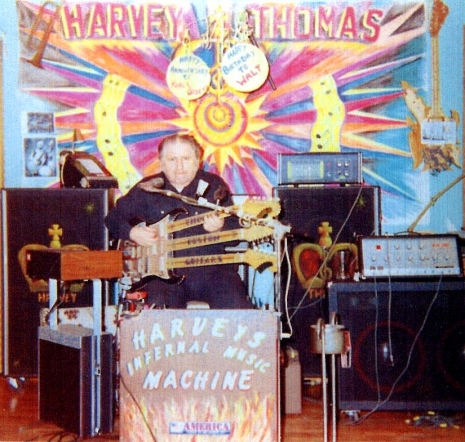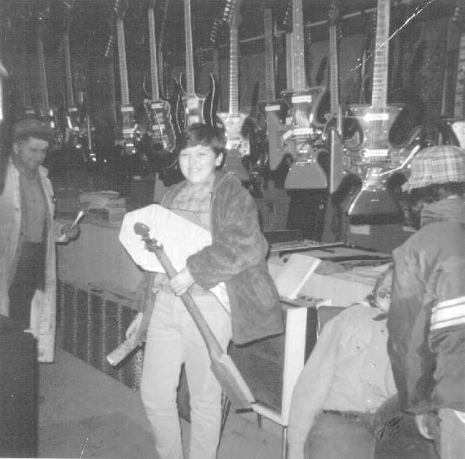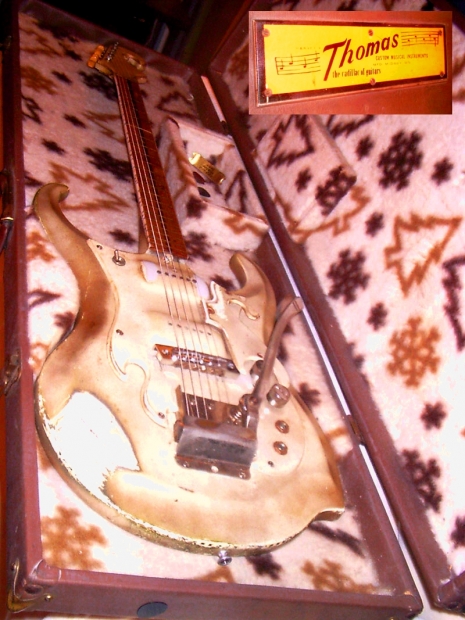
Thanks to Timothy L. Olsen for this wonderful remembrance of guitar-making legend Harvey Thomas.
Remember what the term “Japanese guitar” used to mean, back when Beatniks roamed the earth and Elvis was still kinda nasty?
The Beatles hadn’t landed and I was in the third grade when my big brother Jim brought home a brand new Japanese guitar. Loosely modeled after a classic, it was already caving in from the load of its steel strings. You don’t see them like this anymore, man. Painted-on binding, decal rosette, door skin luan plywood, basswood (or worse) neck, nice sharp ends on those rough brass frets. I was totally fascinated.
But the word fascination found new meaning a year later when my even bigger brother Dick came home from college with what might as well have been the Messiah Stradivarius. It was a very plain, small-bodied New York-era Epiphone archtop with a badly repaired crack running the full length of the soundboard, and he had bought it cheap in a pawn shop. The hand of mortal man never created such perfection. This was a gift from the angels! Oh, the lovely dissonances that it spoke as I whanged it with a juice glass slide! When Dick was begged, he would strum “Who Threw the Overalls in Mrs. Murphy’s Chowder?”
The tenor of my lutherie career was set then and there, as I rushed headlong into the construction of a series of rash and ignorant experiments. The first one to produce a musical note involved bolting the neck of a smashed Gene Autry guitar to a hunk of plywood. By now I was in the 5th grade and the Baby Boom generation was wild about electric guitars thanks to the Mop Tops and other invading Anglos. I made a major life decision to build an electric bass from scratch.
I designed an instrument based on my limited available technology and even more limited engineering savvy, featuring a body made of a sandwich of miscellaneous plywood slabs and a neck which instead of fitting into a slot, surrounded the body like a clothespin. I got the neck fretted, having marked the fret locations on a piece of paper at a music store, then transferring the marks to the oak fretboard, resplendent with 3/4” dowel fret markers.

There I am, a fat fifth grader with my plywood guitar and very big dreams. Harvey to the left, and Harvey’s guitars, including the famous Maltese Cross model, hung along the ceiling. That’s my big sister Ruth on the right in the racing stripe jacket, looking at the Hanged Man dummy.
I got hung up trying to find a pickup. Remember, this was before the Summer of Love. The man at the music store didn’t have access to anything other than those chrome DeArmonds that were used for electrifying archtops. I was persistent and doubtless pitiable. Finally the music store man, against his better judgement it seemed, relented:
“Listen, kid. There’s a guy out in Midway that makes guitars. He’ll have what you need. But I’m warning you, he’s a real character, and I won’t promise that he’ll sell you a pickup. He might like you or he might not.”
Now I had to convince my mom to drive me 25 miles to Midway to see a guy who might or might not like me, and might or might not help me. The thought of not going never occurred to me. A man who makes guitars. This was about the most wonderful thought that had yet crossed my young mind. It is still a pretty thrilling idea, come to think of it. A man who makes guitars!

It took a while to talk her into it, but eventually mom and I were heading north on Highway 99 in the ‘49 Chevy. Midway isn’t really a place, it’s just mid way between Seattle and Tacoma. And this wasn’t really even in Midway. We found the cross street, and turned onto a small road. About a block later a wooden sign with the stenciled word “Thomas” pointed down a pair of ruts bumping off through deep puddles, apparently to nowhere. We followed obediently.
On the right, a heap of rusted and crumpled metal that may once have been a pickup truck of ‘30s vintage held a large sign saying “Bargain. Needs Paint.” We arrived at a modern, low slung, one story house, what you call a “rambler.” It seemed strangely out of place in the swampy, scrub-tree setting. The iron gate held signs warning of dire consequences to trespassers, and to those who dared to block the driveway. A woman looking something like Loretta Lynn told us that Mr. Thomas was out on an errand, but that we could wait in the living room.
Wild tales and even wilder guitars after the jump





